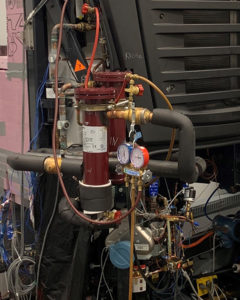By Chris Adam

Researchers at Purdue University developed a sensor to monitor the oil circulation ratio in real time for heating, ventilation, air conditioning and refrigeration systems.
New autonomous sensor technology may help businesses monitor refrigeration and heating systems in real time much faster and easier than current options.
Researchers at Purdue University developed the sensor to monitor the oil circulation ratio in real time for heating, ventilation, air conditioning and refrigeration systems. The oil circulation ratio provides data on the health and functionality of the overall system.
“Our technology is needed as more businesses use variable-speed HVAC systems,” said Orkan Kurtulus, a senior research engineer at Purdue’s Ray W. Herrick Laboratories. “The ability to measure the OCR is critical to ensure the system is using the correct amount of oil for effectiveness and efficiency. Our sensor allows businesses to check the oil circulation without disrupting the system or requiring the tedious process previously used to monitor circulation.”
Capacity control in HVAC&R systems is being used by a growing number of businesses because it increases the efficiency and reduces costs by slowing the speed and energy level when a system does not need to operate at full capacity.
“Our cutting-edge approach for OCR quantification allows otherwise immiscible refrigerant pairs to be separated and analyzed by a sensor in the suction line of HVAC&R systems,” said Vatsal Shah, a research assistant at Herrick Labs. “There remains an unmet need to mitigate oil retention in vapor compression systems, as this can cause inefficiency and even shorten the lifetime of HVAC&R equipment, especially in lieu of new variable speed and tandem compressor technologies, which implement repeated cycles.”
The Purdue team verified the autonomous sensor method using the latest standards from ASHRAE.
The other members of the Purdue team are James Braun, the Herrick Professor of Engineering; Eckhard Groll, the William E. and Florence E. Perry Head of Mechanical Engineering; and Travis Horton, an associate professor of civil engineering.
The team worked with partners in the Ray W. Herrick Labs and the Center for High Performance Buildings. Founded in 1957, Herrick Labs supports world-class mechanical engineering research for students, faculty and industry. Among the facilities in the 83,000 square feet of space are HVAC&R and indoor air quality labs; advanced engine test cells; acoustics, noise, and vibration testing; and unique perception-based engineering labs.
The Purdue innovators worked with the Purdue Research Foundation Office of Technology Commercialization to patent this technology.
The researchers are looking for partners to continue developing their technology. For more information on licensing and other opportunities, contact Dhananjay Sewak of OTC and mention track code 2020-GROL-69138.





Tell Us What You Think!